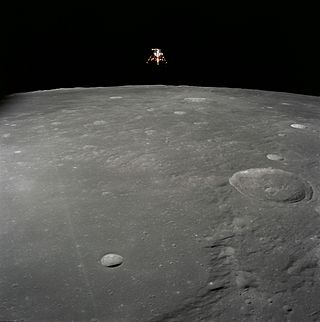Related Research Articles

A lunar lander or Moon lander is a spacecraft designed to land on the surface of the Moon. As of 2023, the Apollo Lunar Module is the only lunar lander to have ever been used in human spaceflight, completing six lunar landings from 1969 to 1972 during the United States' Apollo Program. Several robotic landers have reached the surface, and some have returned samples to Earth.

Masten Space Systems was an aerospace manufacturer startup company in Mojave, California that was developing a line of vertical takeoff, vertical landing (VTVL) rockets, initially for uncrewed research sub-orbital spaceflights and eventually intended to support robotic orbital spaceflight launches.

The physical exploration of the Moon began when Luna 2, a space probe launched by the Soviet Union, made an impact on the surface of the Moon on September 14, 1959. Prior to that the only available means of exploration had been observation from Earth. The invention of the optical telescope brought about the first leap in the quality of lunar observations. Galileo Galilei is generally credited as the first person to use a telescope for astronomical purposes; having made his own telescope in 1609, the mountains and craters on the lunar surface were among his first observations using it.

The Google Lunar X Prize (GLXP) was a 2007–2018 inducement prize space competition organized by the X Prize Foundation, and sponsored by Google. The challenge called for privately funded teams to be the first to land a lunar rover on the Moon, travel 500 meters, and transmit back to Earth high-definition video and images.

Astrobotic Technology inc., commonly referred to as Astrobotic is an American private company that is developing space robotics technology for lunar and planetary missions. It was founded in 2007 by Carnegie Mellon professor Red Whittaker and his associates with the goal of winning the Google Lunar X Prize. The company is based in Pittsburgh, Pennsylvania. Their first launch occurred on January 8, 2024, as part of NASA's Commercial Lunar Payload Services (CLPS) program. The launch carried the company's Peregrine lunar lander on board the first flight of the Vulcan Centaur rocket from Florida's Space Force Station LC-41. The mission was unable to reach the Moon for a soft or hard landing. On June 11, 2020, Astrobotic received a second contract for the CLPS program. NASA will pay Astrobotic US$199.5 million to take the VIPER rover to the Moon, targeting a landing in November 2024.

Hakuto (ハクト) or formerly White Label Space (ホワイトレーベルスペース) was a team formed in early 2008 by a group of experienced space professionals inspired by the challenge of the Google Lunar X PRIZE to develop a robotic Moon exploration mission.
Planetary Transportation Systems (PTS), formerly known as PTScientists and Part-Time Scientists, is a Berlin-based aerospace company. They developed the robotic lunar lander "ALINA" and seek to land on the Moon with it. They became the first German team to officially enter the Google Lunar X-Prize competition on June 24, 2009, but failed to reach the finals in 2017 for lack of a launch contract. During the summer of 2019, the company filed for bankruptcy, and the ALINA project was put on hold. In July 2021, PTS was selected with ArianeGroup to build ESA's ASTRIS kick-stage.
The Rocket City Space Pioneers (RCSP) was one of 29 teams from 17 different countries officially registered and in the competition for the Google Lunar X PRIZE (GLXP) during 2010–2012.
TeamIndus is a private for-profit aerospace company headquartered in Bangalore, India. It consists of a team of professionals from various backgrounds in science, technology, finance, and media, that came together in 2010 with the aim of winning the Google Lunar X Prize competition announced in 2007. Although the competition ended in 2018 without a winner, TeamIndus is still working towards developing and launching their lunar rover mission sometime in 2020 after partnering with OrbitBeyond.

SpaceIL is an Israeli organization, established in 2011, that competed in the Google Lunar X Prize (GLXP) contest to land a spacecraft on the Moon.

The Lunar CATALYST initiative is an attempt by NASA to encourage the development of robotic lunar landers that can be integrated with United States commercial launch capabilities to deliver payloads to the lunar surface.

Electron is a two-stage, partially recoverable orbital launch vehicle developed by Rocket Lab, an American aerospace company with a wholly owned New Zealand subsidiary. Electron was developed to service the commercial small satellite launch market. Its Rutherford engines are the first electric-pump-fed engine to power an orbital-class rocket. Electron is often flown with a kickstage or Rocket Lab's Photon spacecraft. Although the rocket was designed to be expendable, Rocket Lab has recovered the first stage twice and is working towards the capability of reusing the booster. The Flight 26 (F26) booster has featured the first helicopter catch recovery attempt.
MoonLIGHT is a laser retroreflector developed as a collaboration primarily between the University of Maryland in the United States, and the Italian National Institute for Nuclear Physics - National Laboratories of Frascati (INFN-LNF) to complement and expand on the Lunar Laser Ranging experiment started with the Apollo Program in 1969. MoonLIGHT was planned to be launched in July 2020 as a secondary payload on the MX-1E lunar lander built by the private company Moon Express. However, as of February 2020, the launch of the MX-1E has been canceled. In 2018 INFN proposed to the European Space Agency (ESA) the MoonLIGHT Pointing Actuators (MPAc) project and was contracted by ESA to deliver it. MPAc is an INFN development for ESA, with auxiliary support by the Italian Space Agency (ASI) for prototyping work. In 2021, ESA agreed with NASA to launch MPAc with a Commercial Lunar Payload Services (CLPS) mission. Nova-C, the lander on which MPAc will be integrated, is designed by Intuitive Machines and the landing site is Reiner Gamma. The launch expected date is in 2024.

Commercial Lunar Payload Services (CLPS) is a NASA program to hire companies to send small robotic landers and rovers to the Moon's south polar region, mostly with the goals of scouting for lunar resources, testing in situ resource utilization (ISRU) concepts, and performing lunar science to support the Artemis lunar program. CLPS is intended to buy end-to-end payload services between Earth and the lunar surface using fixed-price contracts. The program was extended to add support for large payloads starting after 2025.
ispace Inc. is a public Japanese company developing robotic spacecraft and other technology to compete for both transportation and exploration mission contracts from space agencies and other private industries. ispace's mission is to enable its clients to discover, map, and use natural lunar resources.

Orbit Beyond, Inc., usually stylized as ORBITBeyond, is an aerospace company that builds technologies for lunar exploration. Its products include configurable delivery lunar landers with a payload capacity of up to 300 kg (660 lb), and rovers.

The Intuitive Machines Nova-C, or simply Nova-C, is a class of lunar landers designed by the American company Intuitive Machines to deliver small commercial payloads to the surface of the Moon.

Beresheet was a demonstrator of a small robotic lunar lander and lunar probe operated by SpaceIL and Israel Aerospace Industries. Its aims included inspiring youth and promoting careers in science, technology, engineering, and mathematics (STEM), and landing its magnetometer, time capsule, and laser retroreflector on the Moon. The lander's gyroscopes failed on 11 April 2019 causing the main engine to shut off, which resulted in the lander crashing on the Moon. Its final resting position is 32.5956°N, 19.3496°E.

The Artemis program is a Moon exploration program that is led by the United States' NASA and was formally established in 2017 via Space Policy Directive 1. The Artemis program is intended to reestablish a human presence on the Moon for the first time since Apollo 17 in 1972. The program's stated long-term goal is to establish a permanent base on the Moon to facilitate human missions to Mars.
References
- 1 2 3 Hennigan, W.J. (2011-08-20). "MoonEx aims to scour Moon for rare materials". Los Angeles Times. Retrieved 2011-04-10.
MoonEx's machines are designed to look for materials that are scarce on Earth but found in everything from a Toyota Prius car battery to guidance systems on cruise missiles. ... The company is among several teams hoping to someday win the Google Lunar X Prize competition, a $30-million race to the Moon in which a privately-funded team must successfully place a robot on the Moon's surface and have it explore at least 1/3 of a mile. It also must transmit high definition video and images back to Earth before 2016. ... should be ready to land on the lunar surface by 2013.
- ↑ Brown 2011.
- 1 2
- Moon Express [@MoonEx] (February 9, 2020). "With NASA's Lunar CATALYST program and the GLXP now behind us, we are focused on competing for awards under NASA's CLPS program, which now dominates the commercial lunar landscape of opportunity for small companies" (Tweet). Retrieved 26 February 2020– via Twitter.
- Moon Express [@MoonEx] (February 9, 2020). "There is no upcoming launch with RocketLab. We contracted with RocketLab back in 2015 for a GLXP attempt. We are currently focused on efforts supporting NASA under our Commercial Lunar Payload Services (CLPS) contract" (Tweet). Retrieved 26 February 2020– via Twitter.
- ↑ Chow 2011.
- 1 2 "Moon Express Announces First Successful Flight Test of Lunar Lander System Developed With NASA Partnership". Moon Express. Retrieved August 16, 2011.
- 1 2 Caulfield, Brian. "Naveen Jain: 'Think Of The Moon As Just Another Continent'". Forbes . Retrieved August 16, 2011.
- ↑ Knafo, Saki (July 22, 2011). "The New Space Biz: Companies Seek Cash In The Cosmos". Huffington Post. Retrieved August 16, 2011.
- ↑ "Moving the heaven to get some rare earth". The Hindu . Chennai, India. June 2, 2011. Archived from the original on June 7, 2011. Retrieved June 7, 2011.
- ↑ "NASA - NASA Awards Contracts for Innovative Lunar Demonstrations Data".
- ↑ Hennigan, W.J. (2011-04-08). "MoonEx aims to scour Moon for rare materials". Los Angeles Times. Retrieved 2011-04-10.
- ↑ Sutherland, Paul. "Moon Express to fly lunar telescope". Sen.com. Archived from the original on 14 July 2018. Retrieved 19 August 2012.
- ↑ Lindsey, Clark (2012-12-20). "MoonEx Acquires RCSP of Dynetics" . NewSpace Watch. Retrieved 2012-12-21.
- ↑ Kohlenberg, Brad (2013-09-05). "Moon Express Announces Dr. Paul Spudis as Chief Scientist and Dr. Jack Burns as Science Advisory Board Chair". Google Lunar XPRIZE Blog. Archived from the original on 2013-09-29. Retrieved 2013-09-16.
- ↑ Mohon, Lee (15 May 2015). "NASA's Marshall Space Flight Center's Mighty Eagle Successfully Concludes Test Series".
- ↑ Messier, Doug (2013-12-05). "Moon Express Unveils 'MX-1' Commercial Lunar Lander". Parabolic Arc. Retrieved 2013-12-07.
- ↑ "RELEASE 14-126 NASA Selects Partners for U.S. Commercial Lander Capabilities". NASA.GOV website. NASA. April 30, 2014. Retrieved May 3, 2014.
- ↑ Herridge, Linda (3 March 2015). "Moon Express Completes Initial Flight Tests at NASA's Kennedy".
- ↑ Dean, James (22 January 2015). "Private moon firm to sign deal for test flights at Cape".
- ↑ Foust, Jeff (12 July 2016). "Moon Express takes over Cape Canaveral Delta 2 launch site". Spacenews.
- ↑ Pasztor, Andy (June 5, 2016). "U.S. Set to Approve Moon Mission by Commercial Space Venture". The Wall Street Journal . Retrieved June 6, 2016.
- ↑ "Florida Company Gets Approval to Put Robotic Lander on Moon". The New York Times. 4 August 2016.
- ↑ Erin Mahoney (31 October 2017). "NASA Extends Agreements to Advance Commercial Lunar Landers". NASA.GOV. Retrieved November 2, 2017.
- ↑ "Towers at disused Florida launch pad to be toppled Thursday – Spaceflight Now". spaceflightnow.com. Retrieved 2018-07-12.
- ↑ "Layoffs and stalled projects plagued space start-up Moon Express. Then NASA stepped in".
- ↑ U.S.-BASED MOON EXPRESS ANNOUNCES THE ESTABLISHMENT OF MOON EXPRESS CANADA AND CANADIAN SPACE SECTOR PARTNERSHIPS FOR THE EXPLORATION OF THE MOON Archived 2018-12-16 at the Wayback Machine . Moon Express press release on 16 October 2018.
- ↑ "NASA Announces New Partnerships for Commercial Lunar Payload Delivery Services". NASA. 29 November 2018. Retrieved November 29, 2018.
- ↑ Cape Canaveral's Moon Express among companies selected for NASA lunar program. Emilee Speck, Click Orlando. 29 November 2018.
- ↑ "Intelius' Naveen Jain Turns to Moon Mining, Philanthropy". IndiaWest.com. May 9, 2011. Archived from the original on September 28, 2011. Retrieved June 7, 2011.
- ↑ "Moon Express signs historic launch agreement for private missions to the Moon". Moon Express – Press release. SpaceRef. 1 October 2015. Retrieved 2015-10-05.
- ↑ "Moon Express Launch Contract to be Verified by Google Lunar XPRIZE". SpaceRef. 4 October 2015. Archived from the original on 2015-10-05. Retrieved 2015-10-05.
- ↑ Foust, Jeff (1 October 2018). "Moon Express raises $12.5 million". SpaceNews . Retrieved 6 October 2019.
- 1 2 3 "Moon Express unveils its roadmap for giant leaps to the lunar surface … and back again". GeekWire. 2017-07-12. Retrieved 2017-08-09.
- ↑ Mann, Adam (2013-07-18). "The Private Plan to Put a Telescope on the Moon". Wired. Retrieved 2013-07-21.
- ↑ 'MoonLIGHT' Shines Bright: Moon Express' $24 Million New Science Customer Archived 2018-06-27 at the Wayback Machine . Nick Azer. May 21, 2015.
- 1 2 Speaker Interview: Dr. Alain Berinstain, Vice President of Global Development, Moon Express Archived 2018-12-20 at the Wayback Machine . Space Tech Expo. March 2018.
- ↑ Ex-Prize: Google's $30 Million Moon Race Ends with No Winner. Mike Wall, Space. 23 January 2018.
- 1 2 "Moon Express Technology". Google Lunar X-Prize. November 2010. Archived from the original on 2013-03-27.
- 1 2 "The New Moon: Water, Exploration, and Future Habitation". By Arlin Crotts. Cambridge University Press, Sep 22, 2014. page 147. ISBN 9780521762243
- 1 2 3 4 5 "MX-1 Scout Class Explorer". Moon Express. Archived from the original on 27 October 2019. Retrieved 3 August 2019.
- ↑ Moon Express Unveils Lunar Mission Architecture Archived 2018-03-16 at the Wayback Machine . Press Release - Source: Moon Express. July 12, 2017.
- 1 2 Grush, Loren (12 July 2017). "To mine the Moon, private company Moon Express plans to build a fleet of robotic landers". www.theverge.com. Retrieved 9 August 2017.
- ↑ Moon Express. "We hydrogen peroxide as oxidizer in our bi-prop PECO main engine, & as a monopropellant for our landing & "hopping" thrusters". Twitter.com. Retrieved January 21, 2018.
- ↑ Moon Express unveils its roadmap for giant leaps to the lunar surface … and back again. Alan Boyle, GeekWire. July 12, 2017.